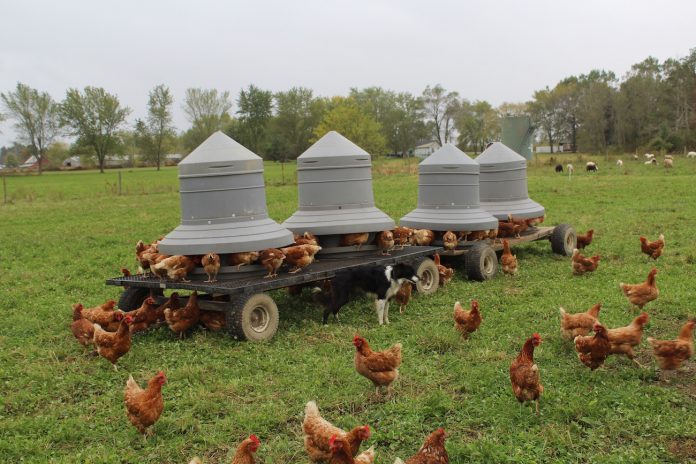UNIVERSITY PARK, Pa. — Outbreaks of highly pathogenic avian influenza, which struck Pennsylvania in early 2022, have continued into the fall. And that has prompted poultry experts in Penn State’s College of Agricultural Sciences to emphasize, once again, the importance of sound biosecurity measures for owners of backyard and commercial flocks.
The U.S. Department of Agriculture reports that as of Nov. 21, avian influenza in 2022 has caused the death of about 50.4 million birds nationally, either directly from the disease or from the culling of flocks to prevent additional spread of the virus.
The avian flu-related loss of layers and turkeys has caused supply issues that — combined with general inflation, rising costs for labor, feed and transportation, and the war in Ukraine — have driven up egg and turkey prices ahead of this year’s Thanksgiving holiday.
In Pennsylvania this year, avian flu outbreaks have impacted 25 commercial poultry flocks and nine backyard flocks, causing the loss of an estimated 4.4 million birds, with the latest detection reported Nov. 10 in Lehigh County.
Containing avian influenza is critical for Pennsylvania’s $7.1 billion poultry industry. The Keystone State ranks fourth nationally in egg production, eighth in turkey production and 12th in broiler production.
The primary natural reservoir for avian influenza is wild waterfowl and shore birds, which often do not become ill, said Gino Lorenzoni, assistant professor of poultry science and avian health. During these wild birds’ migratory seasons in the spring and fall, infected individuals shed the virus in fecal matter and respiratory secretions wherever they go.
He noted that the virus currently circulating — a Eurasian strain of H5N1 avian flu — originated in Europe and was detected in Canada in late 2021. The first detection in wild birds in the United States occurred in January 2022 in South Carolina, and Pennsylvania’s first detection came in March. To date, USDA has reported 59 detections in wild birds in the state.
“That number reflects only those birds that have been sampled,” Lorenzoni said. “If we’ve had 59 sampled birds test positive for highly pathogenic avian flu, we can expect that there likely are thousands more infected with the virus out there in the wild.”
Because this virus is still circulating in nature — and may be for some time — all flock owners should have biosecurity precautions in place, according to John Boney, assistant professor of poultry science and leader of Penn State Extension’s poultry team.
“Historical data suggests that the fall migration presents greater opportunity for infection — we’ve had higher numbers of avian influenza outbreaks in past falls when the virus has been present in the environment,” Boney said. “If you don’t have a biosecurity plan, it’s never too late to start one. Preventing the introduction and spread of this devastating disease is essential.”
Phillip Clauer, associate teaching professor of poultry science and 4-H youth poultry program coordinator for Penn State Extension, explained that biosecurity refers to the preventive measures taken to reduce the risk of introducing infectious agents, such as bacteria, parasites, viruses and other pathogens, into your poultry operation.
“The goal is to keep infectious agents that are outside out and those that are inside in,” Clauer said. “These principles can be applied to any size operation.”
He offered the following recommendations:
- Maintain a line of separation around your flock, such as the walls of a barn or coop or a fence. Keep the area enclosed if possible. Consider risks from anything that can cross over that line, including other birds/animals, people, dust and equipment.
- Prevent contact between your flock and wild birds and their feces. If possible, keep birds inside, especially during outbreaks. Consider adding netting or a tarp over outdoor areas.
- Discourage wild birds from congregating near your flock. Clean up feed spills immediately and minimize habitats for wild birds, such as standing water and overgrown weeds/vegetation. — To reduce the risk of carrying avian influenza back to your flock, avoid places where wild birds/waterfowl may congregate, such as streams, ponds, pastures, golf courses and parks. Assume such places may be contaminated with avian flu virus. Change shoes and clothes that you wear when hunting or fishing before going near your poultry.
- Have dedicated clothes/coveralls and footwear for use only when working with your flock. Sanitize boots, hands and tools before entering your flock premises.
- Limit visitors to only those essential for business, and keep extra coveralls/boots for visitors.
- Don’t visit other flocks, and limit visits to feed and farm supply stores. After such visits, shower and change clothes before returning to your flock. “Although we’re in a time of elevated risk for avian influenza, there is never a time when there’s no risk,” Clauer said. “These biosecurity practices will help limit the risk of many diseases, not just avian flu.”
More information about avian influenza, its symptoms in poultry, biosecurity recommendations and instructions for reporting suspected cases is available on the Penn State Extension website at extension.psu.edu/avian-influenza.











